River Daisy, Swan River Daisy, Cut-leafed Daisy, Australies Madeliefie - Brachyscome multifida
 Condensed Version:
Condensed Version:
This delightful plant has the classic ‘daisy look’ with tiny, daisy shaped flowers and a dense mat of feathery foliage. River daisies come in a range of colours such as pink, mauve, pale and deep blue as well as white; many with striking yellow centres. Yellow forms exist but are uncommon. This sprawling groundcover produces masses of flowers, appearing predominantly in spring and summer but also sporadically throughout the year. It grows about 30 to 50cm wide and 20 to 30cm tall, dependent on the variety and growing conditions. Plant breading has produced numerous cultivars and many improvements to plant form, flower size and colour range. This low maintenance and water-wise plant is a beautiful addition to any garden and is especially effective in mass plantings, producing a very effective and eye-catching ground cover. It is also stunning draping over retaining walls, in pots and hanging baskets. It is quite at home in cottage and rose gardens; a wonderful border plant and excellent in rockeries.
River daisies can be grown in much the same way as other daisies and will tolerate a wide range of conditions; but do not perform well in areas with very hot, humid summers. Despite their delicate appearance, they are surprisingly hardy, growing well at the coast and tolerating quite arid conditions; as well as moderate frost. In severe frost regions the leaves may be burnt but the plant should shoot again in spring if the roots are thickly mulched in winter. In the wild they grow in very shallow sandy soils which drain well, but in the garden they can be grown in a wide range of soil types including light-sandy loams. They will also grow on heavy clay soils, as long as the beds are well prepared and drain well. Like all daisies they love full sun but will tolerate semi-shade, and although they do not need much water once established, will look at their best if watered moderately during long dry spells. Cut back after summer flowering to keep the plants compact and to encourage more flowers. Fertilise each spring and mulch the roots to assist with strong, thick growth and masses of flowers.
Full Version:
Description, History & Interesting Facts:
Brachyscome multifida is an evergreen flowering perennial from eastern Australia which belongs to the daisy (Astereae) family. The species is endemic, meaning it is native only to Australia. In its natural habitat it occurs on dry, shallow or rocky soils, in sclerophyll forests or grasslands in Victoria, New South Wales and Queensland; where it is a food source and resting spot for butterflies. The most common sclerophyll communities in Australia are savannas dominated by grasses with an over-storey of Eucalypts and Acacias.
This delightful plant has the classic ‘daisy look’ with tiny, daisy shaped flowers and a dense mat of feathery foliage. River daisies come in a range of colours such as pink, mauve, pale and deep blue as well as white; many with striking yellow centres. Yellow forms exist but are uncommon. This sprawling groundcover produces masses of flowers, appearing predominantly in spring and summer but also sporadically throughout the year. It grows about 30 to 50cm wide and 20 to 30cm tall, dependent on the variety and growing conditions. Its spreading habit makes it ideal as a ground cover, border plant, or in rockeries. Plant breading has produced numerous cultivars and many improvements to plant form, flower size and colour range.
In the Garden:
This low maintenance and water-wise plant is a beautiful addition to any garden and is especially effective in mass plantings, producing a very effective and eye-catching ground cover. It is also stunning draping over retaining walls, in pots and hanging baskets. It is quite at home in cottage and rose gardens; a wonderful border plant and excellent in rockeries.
![]() Cultivation:
Cultivation:
River daisies can be grown in much the same way as other daisies and will tolerate a wide range of conditions; but do not perform well in areas with very hot, humid summers. Despite their delicate appearance, they are surprisingly hardy, growing well at the coast and tolerating quite arid conditions; as well as moderate frost. In severe frost regions the leaves may be burnt but the plant should shoot again in spring if the roots are thickly mulched in winter. In the wild they grow in very shallow sandy soils which drain well, but in the garden they can be grown in a wide range of soil types including light-sandy loams. They will also grow on heavy clay soils, as long as the beds are well prepared and drain well. Like all daisies they love full sun but will tolerate semi-shade, and although they do not need much water once established, will look at their best if watered moderately during long dry spells. Cut back after summer flowering to keep the plants compact and to encourage more flowers. Fertilise each spring and mulch the roots to assist with strong, thick growth and masses of flowers.
Propagation:
Although most varieties are short-lived, they are easily propagated from cuttings which will strike within a few weeks. Layering is probably the easiest method of propagation because it occurs naturally when the stems lie on the soil.
![]() Pests & Diseases:
Pests & Diseases:
This species is does not suffer from many diseases or pests but is susceptible to Botrytis and powdery mildew when humidity is high and when the foliage is wet. Provide good air circulation to avoid problems with botrytis. Watch out for thrips and whitefly, especially in enclosed and very sheltered gardens. Aphids can sometimes attack the new growth and caterpillars and scale may become a problem.
Creeping Jenny, Penningkruid - Lysimachia
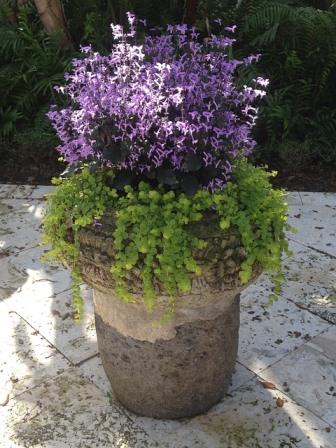 Image by VictoriaLK from PixabayCreeping Jenny is a very popular groundcover in South Africa because it grows easily from the coast to the cold hinterland. However, it is often thought of as a nuisance in the garden because of how well it spreads. It's one of those plants that straddle’s the line between obnoxious invasive and beautiful ornamental, you be the judge. Read all about it below.
Image by VictoriaLK from PixabayCreeping Jenny is a very popular groundcover in South Africa because it grows easily from the coast to the cold hinterland. However, it is often thought of as a nuisance in the garden because of how well it spreads. It's one of those plants that straddle’s the line between obnoxious invasive and beautiful ornamental, you be the judge. Read all about it below.
Condensed Version:
Creeping jenny grows well almost throughout South Africa, from the coast to the cold hinterland. It thrives in regions with high summer rainfall, and although it is particularly associated with damp or even wet areas where it flourishes in semi-shade, in cultivation it will tolerate drier conditions, and can even grow in full sun if the soil is kept consistently moist.
This groundcover is not recommended for very hot and arid regions unless it is given shade, and can be watered regularly. In the winter rainfall regions of the country it does well if watered regularly in summer.
Creeping jenny can struggle in very hot and humid regions, but if it is planted in a cooler part of the garden in fertile soil with excellent drainage, and the plants are well spaced out so they receive maximum air flow they can do really well. Watering moderately during very humid spells, and doing so early in the day will ensure that the leaves do not remain wet for long, thus encouraging fungal diseases.
Creeping jenny is very hardy and easily survives lows of -1°C, and will even tolerate temperatures as low as -10°C, but in these regions the plant will go completely dormant in winter, only to sprout again in spring.
It is tolerant of most garden soils, as long as they are relatively well-draining. Nutrient-rich, loamy-sandy soil is preferred, and excessively sandy or rocky soils are not ideal as they do not have high fertility and don’t retain much moisture.
Prune the plant down hard in spring and feed with a balanced organic fertiliser to encourage lush new growth. This is especially important if you are growing it in a pot.
Full Version:
Description, History & Interesting Facts:
Creeping Jenny (Lysimachia nummularia) is a species of flowering plant in the primrose family Primulaceae. Its common names include; moneywort, creeping jenny, herb twopence and twopenny grass. The genus Lysimachia is native to Eurasia, and consists of around 150 herbaceous or evergreen perennials, as well as shrubs, all of which prefer growing in damp situations, in semi-shade to sun, and in humus rich soils, which drain well. They are common in fens, wet woods, lake shores, and river banks almost throughout Europe.
Due to the creeping growth habit of Lysimachia nummularia this perennial rarely grows taller than 5cm, but can reach considerable widths, quickly forming carpets along the ground and clamouring over stones and rocks. The Latin name "nummularia" means 'like a coin', in reference to the oval shape of the glossy leaves; and hence the common name "moneywort. This plant has been renowned as a wound healer since medieval times and has also been used in Chinese medicine to treat gallstones.
The foliage of creeping jenny remains evergreen in all but hard winters, and the European species (Lysimachia nummularia) with its lovely bright green leaves can be invasive. It has been introduced to many countries like North America where it is now considered an invasive species in some areas, as under favourable conditions such as on low wet ground, or near ponds, it spreads very aggressively, and is quite difficult to remove by hand pulling because any tiny piece left behind will regrow. For this reason, planting this green type is not recommended.
However, the yellow cultivars like 'Aurea' are much less aggressive and suitable for judicious use in ornamental plantings. Lovely bright yellow cup-shaped flowers appear in summer; however, in South Africa flowering can be erratic or non-existent with the yellow forms. Seed capsules do not form readily, so ‘Aurea’ does not spread by seed as readily as the green type will.
Several other Lysimachia species and cultivars like Lysimachia procumbens 'Golden Globes' that displays clusters of bright yellow flowers above glossy green foliage; Lysimachia congestiflora 'Outback Sunset' with its gorgeous broadly ovate green leaves splashed with pale yellow and golden flowers; and the heat tolerant Lysimachia congestiflora 'Midnight Sun' with its attractive deep purple foliage and golden flowers, to name a few, are all really charming. However, in South Africa ‘Aurea’ is the easiest one to find.
Click here to see Google images of 'Golden Globe'
Click here to see Google images of 'Outback Sunset'
Click here to see Google images of 'Midnight Sun'
Golden Creeping Jenny (Lysimachia nummularia 'Aurea')
'Aurea' is the most popular cultivar to use as a groundcover as it is somewhat less aggressive than the other species. It has gained the Royal Horticultural Society's Award of Garden Merit. The foliage is broadly yellow, ranging from lime-green to soft chartreuse if grown in quite a lot of shade, transitioning to a more golden yellow in semi or dappled shade, or a brassy gold in full sun. In very hot regions full sun is not recommended as this will often burn the foliage.
Click here to see Google images of ‘Aurea’
 Lysimachia 'Aurea' Image by Jan Haerer from PixabayIn the Garden:
Lysimachia 'Aurea' Image by Jan Haerer from PixabayIn the Garden:
Use golden creeping jenny carefully to be sure it will not escape from cultivation or crowd out other plants in the garden. This fast-growing plant is incredibly easy to grow and adds colour and a softening of any hard edges wherever it's planted. For these reasons, you might consider planting creeping jenny in containers where it can become an elegant, sweeping plant that hangs over the edges of tall pots or hanging baskets, and doesn't threaten to invade the garden. When designing your containers pair it with taller plants that it won't smother, and contrast it with dark green foliage and brightly coloured flowers.
Creeping jenny is a very useful plant to grow between pavers and stepping stones, and can tolerate light foot traffic. If it can be controlled it makes a wonderful border or groundcover for large shady beds and is a great filler for large rock gardens and rock walls. In small gardens it is not always a good choice for borders, or if planted too close to lawns, as it can spread too aggressively.
It makes a good groundcover with spring flowering bulbs like tulips and daffodils, filling in the space once the bulbs die back for the season. If watered well it also does well under roses, and it complements most shade plants like coleus, begonias, hydrangeas, gardenia, hosta, lady’s mantle, heuchera and all kinds of ferns. The golden foliage of creeping Jenny is particularly striking when combined with darker colours or taller plants.
Members can click on highlighted text to read more about the companion plants mentioned above.
Because it loves moist sites, as long as there is no danger of it escaping into natural areas, it is perfect alongside the edges of streams and ponds, and it can even be grown in a couple of centimetres of water, where it provides a habitat for frogs, insects, and small fish. Those who own an aquarium can even keep creeping jenny in the water, as long as the temperature of the water does not exceed 25°C. In an aquarium, it tends to grow upward, toward the light, rather than creeping along the bottom.
 Cultivation:
Cultivation:
Creeping jenny grows well almost throughout South Africa, from the coast to the cold hinterland. It thrives in regions with high summer rainfall, and although it is particularly associated with damp or even wet areas where it flourishes in semi-shade, in cultivation it will tolerate drier conditions, and can even grow in full sun if the soil is kept consistently moist.
This groundcover is not recommended for very hot and arid regions unless it is given shade, and can be watered regularly. In these regions it would be easier to cultivate it in pots or high water zones of the garden. In the winter rainfall regions of the country it does well if watered regularly in summer.
Creeping jenny can struggle in very hot and humid regions, but if it is planted in a sunny but cooler part of the garden, in fertile soil with excellent drainage, and the plants are well spaced out so they receive maximum air flow they can do really well. Watering very moderately during very humid spells, and doing so early in the day will ensure that the leaves do not remain wet for long, thus encouraging fungal diseases.
Creeping jenny is very hardy and easily survives lows of -1°C, and will even tolerate temperatures as low as -10°C, but in these regions the plant will go completely dormant in winter, only to sprout again in spring.
This accommodating little groundcover is tolerant of most garden soils, as long as they are relatively well-draining, be they acid, alkaline or neutral. Nutrient-rich, loamy-sandy soil is preferred, and excessively sandy or rocky soils are not ideal as they do not have high fertility and don’t retain much moisture.
Prune the plant down hard in spring and feed with a balanced organic fertiliser to encourage lush new growth. This is especially important if you are growing it in a pot.
 Problems, Pests & Diseases:
Problems, Pests & Diseases:
If creeping jenny is happy where it is growing it suffers from very few serious pests or diseases.
Slugs and snails may creep in between the foliage and take a few nibbles, but in some places slugs may attack the leaves and nearly completely defoliate the plants when high populations are present. If this is the case, remove them by hand by hunting at night with a torch when they are most active, or by setting a trap. Beer traps work well and will draw snails from other parts of the garden too. Simply dig a bucket or tray into the ground at the soil level and fill it with a can of beer. The snails will be attracted into the bucket by the smell of the beer, where they drown in the liquid.
If you are incredibly unlucky you may find aphids or caterpillars settling on your plants, but usually these bugs prefer tastier morsels in the garden. If you do discover any, simply remove them by hand and place them in a bucket of soapy water. You can also apply horticultural oil to the foliage to suffocate the bugs and prevent any eggs they may have laid from hatching.
Also watch out for red spider mites, leafminers, whiteflies, mealybugs, and thrips.
Creeping Jenny doesn't usually have problems with diseases, but during cold or hot, very rainy conditions, or if it's located in a very humid environment, it may fall prey to fungal diseases like rust and leaf spots, both of which can be treated with an organic fungicide. Planting in a more sunny and open position with good air flow, and also pruning often to improve airflow, and removing any diseased or dying branches as soon as they are spotted will help control the development of these diseases.
Warning:
Pet owners do not need to worry about creeping jenny as it is non-toxic for pets or humans, and is still used as a medicinal plant.
Houttuynia 'Harlequin' - Houttuynia cordata
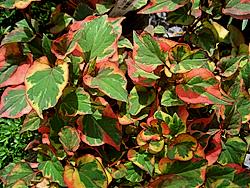 Houttuynia cordata 'Chameleon'The Chameleon Plant (Houttuynia cordata 'Chamaeleon') is listed as a Category 3 invasive. Read more below on how this affects you if you have this plant growing on your property.
Houttuynia cordata 'Chameleon'The Chameleon Plant (Houttuynia cordata 'Chamaeleon') is listed as a Category 3 invasive. Read more below on how this affects you if you have this plant growing on your property.
Years ago this little evergreen with its colourful leaves and tiny white summer flowers became a popular groundcover because it grew well throughout most of South Africa, remaining low and spreading willingly through the garden. Its unusual ivy-shaped leaves were the main attraction, sporting multi-coloured hues of yellow, red, pink, green or orange, hence it other common name “harlequin plant”.
However, it was noted early on that this plant could become invasive, and certainly was very invasive in damp areas that are semi-shaded, where the plant flourished and spread at a rapid rate. So rapidly that it is now a Category 3 invasive in South Africa, meaning it may no longer be sold or propagated, and its invasion on a property must be controlled by a Competent Authority. You can’t simply dig it up, bag it, and allow the municipality to take it to the dump, because this will only spread the plant even further abroad. So if you have a large property which is overtaken find out who is in charge of overseeing the disposal.
I assume that for smaller gardens it would be fairly easy to eliminate by continually digging up any growth and allowing it to dry out totally before burning it or burying it deeply. If you have this plant try to eradicate it completely, as if you wish to sell one day, you are legally obliged to notify the purchaser of the presence of any Category 3 invader species on the land.
Wild Cineraria, Geelblom - Cineraria saxifraga
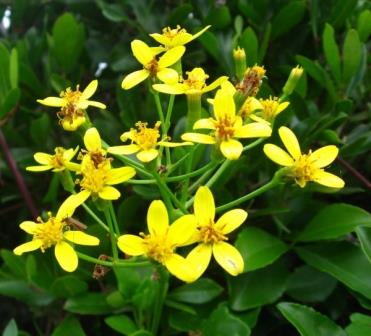 Cineraria saxifraga Condensed Version:
Cineraria saxifraga Condensed Version:
This pretty little indigenous perennial forms a mounding groundcover, +-20 to 30cm tall with a spread of about 40 to 50cm. Because the branches are low they will make roots wherever they touch the soil, so the plant can spread much further with time. The dainty succulent leaves are broadly triangular to rounded, bright green, and very attractive. The tiny sunflower-yellow blooms on fragile stalks are most prolific in spring and autumn, but also bloom during summer. Very small, black seeds with a tuft of fluffy whitish hairs at one end follow the flowers, and because they are very light, are dispersed by the wind. The wild cineraria with its delicate foliage and bright yellow flowers, is a rewarding and versatile plant for the garden, doing extremely well in coastal gardens. This super tough, low maintenance little plant can be used as a groundcover and for stabilising the soil on steep banks. It is impressive when spilling over retaining or terraced walls and steps. Combine it with other plants in window boxes and hanging baskets for hassle free colour. It is invaluable in indigenous and water-wise gardens, and because it loves growing amongst rocks in light shade, it is also an excellent candidate for rock or pebble gardens.
Wild cineraria grow quickly and easily both at the coast and inland. It tolerates windy conditions at the coast and although it thrives in frost-free regions of the country, is also semi-hardy to frost, taking temperatures down to -1°C if planted in a sheltered position in the garden. It does best in extremely well-drained soil with added compost, and thrives in the garden in full sun to light shade. Water regularly until established, and moderately thereafter during prolonged dry spells. An occasional feeding with a balanced fertiliser and yearly mulch should be sufficient to keep them at their blooming best. Plants do not require pruning, but can be trimmed occasionally to remove dead flowers and encourage bushiness.
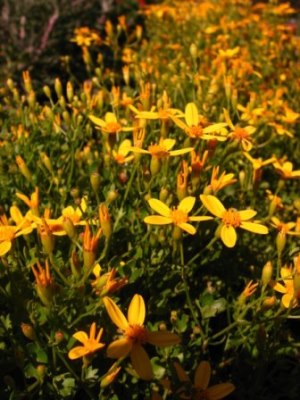 Cineraria saxifraga Full Version:
Cineraria saxifraga Full Version:
Description, History & Interesting Facts:
This pretty little perennial belongs to the daisy family (Asteraceae) and is a relative of the sunflower. The genus includes about 50 species which are endemic and restricted only to the southern areas of South Africa, from Swellendam in the Western Cape to the Eastern Cape, southern KwaZulu-Natal, and extending into Lesotho and Swaziland. It grows all along the coast and adjacent interior, and is common on stony hillsides and rocky outcrops, usually growing in light shade. The species name saxifraga means “of the rocks” in Latin and alludes to this species preference for a rocky habitat. The common name “wild cineraria” can be a bit misleading because it does not look at all like the brightly coloured annuals we grow in our gardens called Florist's Cineraria (Pericallis x hybrid.) These annuals are hybrids between two species from the Canary Islands, which are no longer included in cineraria but have been placed in the genus Pericallis, as the botanists try to bring taxonomic order to the huge and diverse daisy family.
The wild cineraria will form a mounding groundcover, +-20 to 30cm tall with a spread of about 40 to 50cm. Because the branches are low they will make roots wherever they touch the soil, so the plant can spread much further with time. The dainty succulent leaves are broadly triangular to rounded, bright green, and very attractive. The tiny sunflower-yellow blooms on fragile stalks are most prolific in spring and autumn, but also bloom during summer. Very small, black seeds with a tuft of fluffy whitish hairs at one end follow the flowers, and because they are very light, are dispersed by the wind.
In the Garden:
The wild cineraria with its delicate foliage and bright yellow flowers, is a rewarding and versatile plant for the garden, doing extremely well in coastal gardens. This super tough, versatile little plant can be used as a groundcover and for stabilising the soil on steep banks. It is impressive when spilling over retaining or terraced walls and steps. Combine it with other plants in window boxes and hanging baskets for hassle free colour. It is invaluable in indigenous and water-wise gardens, and also looks pretty in cottage and wild gardens. Because it loves growing amongst rocks in light shade, it is also an excellent candidate for rock or pebble gardens. Being very low maintenance, the wild cineraria is great for public gardens, traffic islands, office parks, parking lots and school yards. An added bonus is that it will attract honey bees and butterflies to your garden, as well as insect eating birds.
 Cultivation:
Cultivation:
Wild cineraria grow quickly and easily both at the coast and inland. It tolerates windy conditions at the coast and although it thrives in frost-free regions of the country, is also semi-hardy to frost, taking temperatures down to -1°C if planted in a sheltered position in the garden. It does best in extremely well-drained soil with added compost, and thrives in the garden in full sun to light shade. In too much shade it will not flower as abundantly, and a plant in a sunny situation will be more compact than one in a shadier spot. Water regularly until established, and moderately thereafter during prolonged dry spells. An occasional feeding with a balanced fertiliser and yearly mulch should be sufficient to keep them at their blooming best. Plants do not require pruning, but can be trimmed occasionally to remove dead flowers and encourage bushiness. These perennials will last for a number of years, but may become a bit woody and scruffy with age; so to keep the beds looking at their best, replace them with young plants every four to five years by digging up old plants and replacing them with young runners which have rooted.
Propagation:
Cineraria saxifraga is easily propagated by means of seed or cuttings, or rooted runners can be removed from an established plant. Propagation from rooted runners is the easiest for gardeners, but cuttings taken during spring, summer or autumn root easily if treated with a rooting hormone powder. Plant in a well-drained growing medium and place them in a cool spot. Using a bottom heat of +-23°C, together with intermittent misting, will greatly aid rooting. In frost free climates seed can be sown in autumn, spring or early summer, but in colder regions they are best sown in spring.
 Pests & Diseases:
Pests & Diseases:
If grown correctly and in perfectly drained soil, wild cineraria suffer from no serious pests or diseases - another good reason to plant some in your garden.
Josephs Coat - Alternanthera bettzichiana
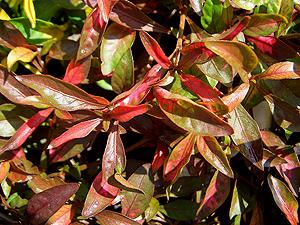 Alternanthera bettzickiana 'Pink'Condensed Version:
Alternanthera bettzickiana 'Pink'Condensed Version:
Garden varieties of Alternanthera bettzickiana are are available in gorgeous leaf shades of rose, pink, red, yellow, bronze, green, purple, and cream, and remain popular groundcovers.
This little plant grows as an evergreen perennial in the warm, moist, frost free, subtropical regions of the country. In the winter rainfall regions it will need moderate watering during the dry months, and in the cold regions of the country it is semi-hardy to moderate frost. In cold regions, mulch the roots well in autumn, and even if the plant does die down in winter, it will more often than not re-sprout again in spring.
The plant is highly recommended for regions with saline soils, and this salt tolerance makes it ideal for coastal gardens. And, although it adapts to most garden soils, in poor soils try to add as much organic matter as you can in order to encourage lush growth and to conserve moisture, as the plants look at their best if watered regularly. In order to keep their bright colours the leaves require sunshine, so site your plants where they receive full sun or partial shade.
This plant will keep its vibrant red and pink hues with relative ease, but if nutrients and lighting are severely lacking, the leaves can ‘dull out’ to an orange hue, so ensure that it receives sufficient sunlight, and feed regularly with a balanced plant food with.
Regular trimming will keep the plant vigorous and neat.
Full Version:
Description, History & Interesting Facts:
Alternanthera bettzickiana, commonly known as “Joseph’s Coat” or “Calico-plant”, is a species of flowering plant in the family Amaranthaceae, commonly known as the “amaranth” (Amaranthus). The genus Alternanthera is estimated to have between 80 and 200 species, most of which occur in the tropical Americas, and some in Asia, Africa, and Australia. Most species are spreading plants like Alternanthera bettzickiana, and several are aquatic in habit.
Alternanthera bettzickiana probably originated in Brazil, but is very widely cultivated, and today it is a popular ornamental in tropical and subtropical gardens. It is commonly cultivated in Asia where it is especially popular in China, and also in Africa, North America, Central America, the Caribbean, South America, Europe and Oceania
Joseph’s coat is an herbaceous perennial herb which grows around 20 to 50cm tall, and in its native habitat it is found with stems that can be either erect, or creeping and much-branched, and the leaf blades can be green or red, various shades of purple, or sometimes tinged with both red and yellow. The inflorescence is a spike or a rounded head occurring in the leaf axils or the ends of branches.
Garden varieties are more compact and are available in gorgeous leaf shades of rose, pink, red, yellow, bronze, green, purple, and cream. And, although the plant will grow in semi-aquatic situations, this species is not the invasive nuisance that its close relative, alligator weed, is.
Alligator weed, (Alternanthera philoxeroides) is a very well-known South American species which was spread to many countries. It has become a noxious weed in many parts of the world, as it quickly creates a floating mass which spreads out over water, and its rampant growth quickly disrupts the ecology of banks and shallows, crowding out native plant species, restricting the flow of the water, increasing sedimentation, and aggravating flooding, amongst other unfavourable consequences.
Click here to see Google images of Alligator Weed
There are no published reports about the invasiveness of A. bettzickiana, and in most of the countries where it occurs it is reported only as an ornamental species. In Texas it is not considered as a threat to native plant communities, although it is known to occasionally escape and grow in disturbed areas close to where it was originally grown. The same applies for India and Taiwan where it is reported as common but not invasive.
However, in the British Virgin Islands, Costa Rica, Colombia, Dominican Republic, Peru and St. Lucia, A. bettzickiana has escaped and naturalized. So, even though it is not listed as being invasive in South Africa, and in many other countries where it is grown, I believe that we should still be cautious with this species, and never ever plant it near wild areas where it could encroach. Rather keep it securely in the garden where you can keep an eye on it.
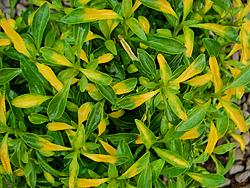 Alternanthera bettzickiana 'Yellow'Uses:
Alternanthera bettzickiana 'Yellow'Uses:
Intensive agricultural practices include feeding and spraying programmes that result in higher heavy metal contamination of both the soil and water, and studies done to evaluate the morpho-physiological and biochemical response along with phyto-extraction potential of Alternanthera bettzickiana for cobalt (Co) and copper (Cu) contaminated soil concluded that A. bettzickiana is a potential hyper accumulator and halophyte of Co and Cu, and therefore an excellent potential candidate for the remediation of Cu and Co contaminated sites.
In the Kitchen:
The tender leaves have a mild flavour and can be eaten raw in salads, or cooked like spinach and used in soups. The leaves are also mixed with other vegetables and served with staple foods like rice, and ugali or sima, a type of stiff maize-flour porridge made in Africa.
Health Benefits:
Alternanthera bettzickiana is useful in purifying and nourishing the blood, and the cooked vegetable is given to anaemic children in order to improve their health. It is acclaimed for its wound healing characteristics, and is used as a soft laxative. It is also known as a galactagogue that increases milk supply, and an antipyretic that reduces fever.
Investigations evaluating the preliminary phytochemical screening and antimicrobial activity of aerial parts of Alternanthera bettzickiana, tested against various Gram positive, Gram negative bacteria and fungi concluded that a plant extract of A. bettzickiana showed remarkable antimicrobial activity due to the phytochemicals present in them.
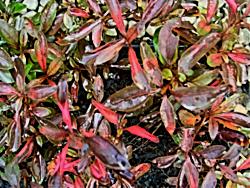 Alternanthera bettzickiana 'Red'In the Garden & Home:
Alternanthera bettzickiana 'Red'In the Garden & Home:
Joseph’s coat is a popular ornamental worldwide and is particularly popular in China, where it is cultivated in all the large cities, where it thrives in full sun to partial shade. Because the plant has an extensive root system it is planted in plantations as a ground cover to prevent soil erosion. The plant can even be trimmed and grown as a low hedge. This little plant is great for adding impact and contrast to mixed borders and plantings, including pots.
Garden varieties with dark purple or red leaves really stand out in the garden, and being of a darker hue they always make excellent background subjects for mass plantings with paler shades in the foreground. However, use them sparingly to avoid creating an overall dark overtone to the landscape.
Joseph’s coat can even be grown indoors, and is a well-known terrarium plant, and if grown in strong light, the foliage colour will remain intense.
Even though Alternanthera bettzickiana is not a true aquatic plant, it is highly recommended for aquariums as it provides great coverage for sensitive aquatic species, and is an easier choice for beginners who are looking for coloured aquarium plants. Because of its ability to survive underwater for a long period of time, many hobbyists use this plant in as an alternative for other true aquatic plants, because they claim it can last longer than some of the true aquatic plants, and may even grow a few inches taller and develop roots in the aquarium.
However, it can only be submerged for several months at a time, after which it should be removed from the water for a few months so it can restore its energy before being submerged once again. For this reason it would be worthwhile to cultivate more than one at a time in order to always have one ready for the aquarium. When grow emerged, or out of the water, the plant should be kept in a consistently humid environment with wet soil.
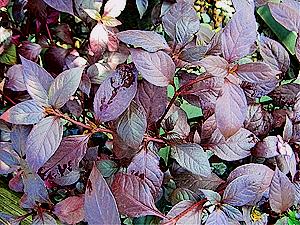 Alternanthera 'purple'Cultivation/Propagation:
Alternanthera 'purple'Cultivation/Propagation:
This joyful little plant grows as an evergreen perennial in the warm, moist, frost free, subtropical regions of the country. In the winter rainfall regions it will need moderate watering during the dry months, and in the cold regions of the country it is semi-hardy to moderate frost. In cold regions, mulch the roots well in autumn, and even if the plant does die down in winter, it will more often than not re-sprout again in spring.
The plant is highly recommended for regions with saline soils, and this salt tolerance makes it ideal for coastal gardens. And, although it adapts to most garden soils, in poor soils try to add as much organic matter as you can in order to encourage lush growth and to conserve moisture, as the plants look at their best if watered regularly. In order to keep their bright colours the leaves require sunshine, so site your plants where they receive full sun or partial shade.
This plant will keep its vibrant red and pink hues with relative ease, but if nutrients and lighting are severely lacking, the leaves can ‘dull out’ to an orange hue, so ensure that it receives sufficient sunlight, and feed regularly with a balanced plant food with.
Regular trimming will keep the plant vigorous and neat.
It is easily propagated by cuttings.
 Problems, Pests & Diseases:
Problems, Pests & Diseases:
Alternanthera bettzickiana is remarkably pest-resistant, but is a major host of the cactus mealybug (Hypogeococcus pungens). Cactus mealybugs can attack a wide range of houseplants and greenhouse ornamentals, including cacti and succulents, African violets, ferns and orchids.
Keep an eye out for any white spots on your plants and remove them immediately. There are a few ways to get rid of mealybugs, depending on the level of infestation. If there are only a couple, you can either scrape them off one by one, or for bigger infestations you can spray on rubbing alcohol or soapy water and oil, or simply apply a systemic insecticide
Warning:
I found no known hazards listed for Alternanthera bettzickiana
Evening Primrose - Oenothera 'African Sunset'
Sea Lavender, Perez's sea lavender, Papierblom - Limonium perezii
Purple Coneflower - Echinacea purpurea
Periwinkle - Vinca
 Vinca major Image by For commercial use, some photos need attention. from PixabayDid you know that the large blue periwinkle, gewone-opklim (Vinca major) is a category 1B invasive plant in South Africa? However sterile cultivars or hybrids of Vinca minor are not listed. Read more below what this means for you and what the regulations are.
Vinca major Image by For commercial use, some photos need attention. from PixabayDid you know that the large blue periwinkle, gewone-opklim (Vinca major) is a category 1B invasive plant in South Africa? However sterile cultivars or hybrids of Vinca minor are not listed. Read more below what this means for you and what the regulations are.
All the periwinkles come from Europe, central Asia and northern Africa; and the large periwinkle (Vinca major) is native to France and Italy, and eastward through the Balkans to northern Asia Minor and the western Caucasus. Vinca minor is often called the lesser, or common periwinkle because its leaves and flowers are smaller than the large periwinkle.
Because both are beautiful evergreen perennials that are extremely easy to grow, with attractive, glossy leaves and lovely violet-purple, pale purple or white flowers, they quickly became very popular with gardeners as a groundcover or trailing plant for semi-shade to sun.
In cultivation the plants generally do not bear fruit, and spread vigorously by rooted runners, and this is how they escaped garden cultivation. Both, but especially Vinca major, will often outgrow their original site, and when pruned or dug out by the roots and disposed of with the garden refuse, these remarkable plants will start rooting wherever they are discarded and will quickly colonize a whole new area.
Periwinkles grow throughout South Africa but the large periwinkle (Vinca major) is particularly problematic in KwaZulu-Natal, and both the Eastern and Western Cape. A variegated form is also available which has a similar, invasive habit. And, although sterile cultivars and Vinca minor are not listed, I believe we should exercise caution when growing these too, as they also spread via rooted runners, and in other areas of the world people are debating their invasiveness.
 Vinca major 'Variegata' Picture courtesy Leonora Ellie Enking from flickrSo what does this mean for you if you have Vinca major growing in your small garden or even on a large property or farm? Category 1b invasive species in South Africa require compulsory control as part of an invasive species control process. These plants are deemed to have such a high invasive potential that infestations can qualify to be placed under a government sponsored invasive species management programme. Wherever possible, the plants must be removed and destroyed responsibly, and no permits will be issued to keep these species.
Vinca major 'Variegata' Picture courtesy Leonora Ellie Enking from flickrSo what does this mean for you if you have Vinca major growing in your small garden or even on a large property or farm? Category 1b invasive species in South Africa require compulsory control as part of an invasive species control process. These plants are deemed to have such a high invasive potential that infestations can qualify to be placed under a government sponsored invasive species management programme. Wherever possible, the plants must be removed and destroyed responsibly, and no permits will be issued to keep these species.
You can spot the large periwinkle easily in the wild because it grows so rampantly, and especially in moist, shaded areas, along forest edges, streambanks and roadsides, and where moisture is sufficient it will also thrive in full sun. It can grow so rampantly that the trailing stems will form dense mats of vegetation - about half a metre high, completely covering the surrounding plants, blocking out the light and competing for nutrients. This completely changes the habitat and ecosystem, and since infestations often occur in fragile environments like forests and alongside streams, this has serious implications for our biodiversity.
No herbicides are registered specifically for use on periwinkle, but a systemic herbicide sprayed on the leaves may kill the plants. Small infestations can be removed by hand-pulling, but ensure that all parts of the stems are carefully removed since any fragments will merely regrow. I never found any advice on how to safely dispose of the plants, but I would imagine that allowing them to dry out and then burning them would be good, or digging a very deep trench and burying them so deep that they cannot sprout and become compost is good?
The leaves contain toxins and are generally not browsed by animals. Gardeners and farmers are strongly urged to remove these plants, and to replace them with some of our most beautiful indigenous plants such as the Bush Violets (Barleria obtusa and Barleria repens), or for more sunny sites our gorgeous African Daisies (Dimorphotheca)


